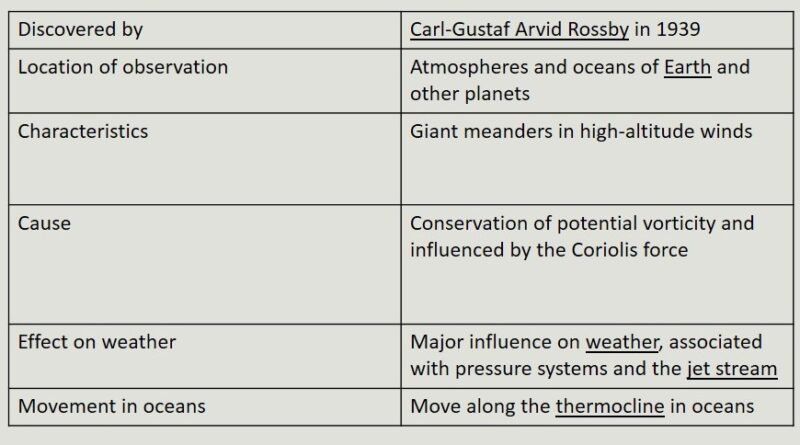Rossby Waves
– Rossby waves are large-scale atmospheric and oceanic waves that propagate westward in the mid-latitudes.
– They are a result of the Coriolis force, which acts on moving objects in the rotating frame of the Earth.
– The Coriolis force causes a deflection of the wind in the direction perpendicular to the motion, leading to the formation of Rossby waves.
– The Rossby number, which is the ratio of inertial to Coriolis forces, determines the strength of the Coriolis force and the formation of Rossby waves.
– Rossby waves are responsible for the westward propagation of weather systems in the mid-latitudes, such as cyclones and anticyclones.
– They also play a crucial role in the formation of the jet stream, which is a narrow band of strong winds in the upper atmosphere that steer weather systems.
– Rossby waves are also present in the ocean, where they are known as planetary waves and are responsible for the westward propagation of ocean currents.
– The characteristics of Rossby waves, such as their wavelength, amplitude, and phase speed, are determined by the Coriolis force, the background flow, and the topography of the Earth.
– Rossby waves are important for the prediction of weather and climate, as they can influence the distribution of temperature, precipitation, and storm tracks.
– They are also sensitive to climate change, as changes in the temperature, humidity, and wind patterns can affect the formation and propagation of Rossby waves.
– Understanding the physics of Rossby waves is crucial for the development of accurate weather and climate models, as well as for the prediction of extreme weather events, such as hurricanes and floods.
Features of Rossby Waves:
– Rossby waves are characterized by their long wavelength, low frequency, and westward propagation.
– They are formed by the interaction of the Coriolis force, the background flow, and the topography of the Earth.
– The wavelength of Rossby waves is typically several thousand kilometers, and their phase speed is a few meters per second.
– The amplitude of Rossby waves can vary, depending on the strength of the Coriolis force, the background flow, and the topography of the Earth.
– Rossby waves can be stationary or traveling, and they can interact with each other to form complex wave patterns.
– The phase speed of Rossby waves is determined by the Coriolis force and the background flow, and it can vary with latitude and altitude.
– Rossby waves can be disrupted by topographic features, such as mountains and islands, which can lead to the formation of wave trains and blocking patterns.
– The amplitude and phase of Rossby waves can be modulated by the background flow, which can lead to the formation of Rossby wave resonance and Rossby wave critical layers.
Importance of Rossby Waves:
– Rossby waves are important for the prediction of weather and climate, as they can influence the distribution of temperature, precipitation, and storm tracks.
– They are also sensitive to climate change, as changes in the temperature, humidity, and wind patterns can affect the formation and propagation of Rossby waves.
– Understanding the physics of Rossby waves is crucial for the development of accurate weather and climate models, as well as for the prediction of extreme weather events, such as hurricanes and floods.
– Rossby waves also play a crucial role in the transport of heat, moisture, and momentum in the atmosphere and ocean, which can affect the global climate system.
– The study of Rossby waves is also important for the understanding of the dynamics of the Earth’s atmosphere and ocean, as well as for the prediction of space weather and the behavior of the Sun.
Rossby waves are large-scale atmospheric and oceanic waves that propagate westward in the mid-latitudes, and they are a result of the Coriolis force, which acts on moving objects in the rotating frame of the Earth. They are characterized by their long wavelength, low frequency, and westward propagation, and they are important for the prediction of weather and climate, as well as for the understanding of the dynamics of the Earth’s atmosphere and ocean. Understanding the physics of Rossby waves is crucial for the development of accurate weather and climate models, as well as for the prediction of extreme weather events, such as hurricanes and floods.
Source: Springer
